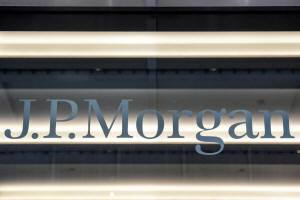Explainer-How a massive options trade by a JP Morgan fund can move
markets
 Send a link to a friend
Send a link to a friend
 [October 01, 2022] By
Saqib Iqbal Ahmed [October 01, 2022] By
Saqib Iqbal Ahmed
NEW YORK (Reuters) - A nearly $16 billion
JP Morgan fund is expected to reset its options positions on Friday,
potentially adding to equity volatility at the end of a gloomy quarter
for stocks.
Analysts have in the past pointed to the JPMorgan Hedged Equity Fundís
quarterly reset roiling markets, and see it as a source of potential
volatility during Friday's session.
WHAT IS THE JP MORGAN HEDGED EQUITY FUND?
The JPMorgan Hedged Equity Fund holds a basket of S&P 500 stocks along
with options on the benchmark index and resets hedges once a quarter.
The fund, which had about $15.59 billion in assets as of September 28,
aims to let investors benefit from equity market gains while limiting
their exposure to declines.

For the year, the fund was down 10.66% through September 28, compared
with a 21% decline for the S&P 500 Total return Index.
The fund's assets ballooned in recent years, as investors sought
protection from the sort of wild swings that rocked markets in the wake
of the COVID-19 outbreak in March 2020.
Its holdings include some of the market's biggest names, such as Apple
Inc, Microsoft Corp and Amazon.com Inc.
HOW DOES THE FUND USE OPTIONS?
The fund uses an options strategy that seeks to protect investors if the
S&P 500 falls between 5% and 20%, while allowing them to take advantage
of any market gains in the average range of 3.5-5.5%. On June 30, the
refresh of the fund's options positions involved about 140,000 S&P 500
options contracts in all, including S&P 500 puts at strikes 3580 and
3020 and calls at 4005, all for the September 30 expiry.
HOW CAN THIS AFFECT THE BROADER MARKET?
Options dealers - typically big financial institutions that facilitate
trading but seek to remain market-neutral - take the other side of the
fund's options trades.
[to top of second column] |

A JPMorgan logo is seen in New York
City, U.S., January 10, 2017. REUTERS/Stephanie Keith/File
Photo/File Photo

To minimize their own risk, they typically buy or sell stock
futures, depending on the direction of the market's move. Such
trading related to dealer hedging has the potential to influence the
broader market, especially if done in size, as is the case for the
JPM trade.
The trade is "well understood" and "mostly digested by the market,"
said Chris Murphy, co-head of derivatives strategy at Susquehanna
International Group.
It has, however, exacerbated daily moves in the past, according to
some analysts.
The S&P 500 Index fell 1.2% in the last hour of trading on March 31
amid a lack of any obvious news - a move some analysts pinned on
options hedging flows.
Analysts say the refresh could exacerbate market swings on Friday,
as the fund rolls over its options positions and dealers buy and
sell futures to hedge their exposure.
"That's because there is a fair amount that has to be adjusted and
hedged to roll the trade," said Brent Kochuba, founder of analytic
service SpotGamma.
"I believe that the position is expanding volatility this week,"
Kochuba said.

All else being equal, once the options position is rolled forward
three month out, their influence on current price swings should
diminish, he said.
(Reporting by Saqib Iqbal Ahmed in New York; Editing by Ira
Iosebashvili and Matthew Lewis)
[© 2022 Thomson Reuters. All rights
reserved.]
This material may not be published,
broadcast, rewritten or redistributed.
Thompson Reuters is solely responsible for this content. |